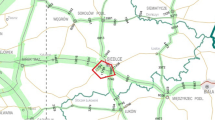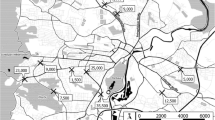Abstract
There is currently much public opposition to the construction of municipal refuse incinerators in the United States owing to health concerns about emitted toxicants. In this study, 19 elements and polychlorinated biphenyls (PCBs) were determined in grasses sampled upwind and downwind from a municipal refuse incinerator which had no emission control devices. Concentrations of Cd, Mo, Hg, Zn, Fe, and Pb were generally highest immediately adjacent to the incinerator. Foliar concentration of the metals, Cd, Mo, Zn, Fe, and Pb was inversely related to the logarithm of the distance downwind from the incinerator. Foliar concentration of Hg decreased linearly with distance downwind. Polychlorinated biphenyls were not detectable in any of the grass samples possibly due to their thermal destruction during incineration or greater dispersion because of their higher vapor pressure. The metal concentration in plants in the vicinity of such incinerators will be affected by the composition of the refuse, incinerator design and stack height, combustion operating conditions, emission control devices, the nature of the plant surface, the water solubility of deposited metal-containing particulates, prevailing weather conditions and root uptake of such metals by plants.
Similar content being viewed by others
References
Bergstrom (1986) Mercury behavior in flue gases. Waste Manage Res 4:57–64
Boniforti L, Citti G, Laguzzi G (1981) Identification and quantitative determination of polychlorinated biphenyls and polynuclear aromatic hydrocarbons in fly ash from municipal incinerators by gas chromatography with electron-capture detection and gas chromatography-mass spectrometry. Recent Dev Mass Spectrom Biochem, Med Environ Res 7:219–225
Bowen HJM (1979) Environmental chemistry of the elements. Academic Press, NY
Brunner PH, Mönch H (1986) The flux of metals through municipal solid waste incinerators. Waste Manage Res 4:105–119
Campbell WJ (1976) Metals in the wastes we burn? Environ Sci Technol 10:436–439
Collins WG, Zordan TA (1985) PCBs destroyed by burning with municipal waste. Mod Power Syst 5:50–52
Dumarey R, Dams R (1985) Selective gathering of mercury-batteries: A possible way to lower mercury emissions from a municipal waste incineration plant. Environ Technol Lett 6:149–152
Gajan RJ, Larry D (1972) Determination of lead by atomic absorption spectrophotometry and by polarography. 1. Development of the methods. J Assoc Offic Anal Chem 55:727–732
Genest VW, Reimann DO (1985) Die abfallproblematik von altbatterien. Müll Abfall 7:217–224
Gorsuch TT (1970) The Destruction of Organic Matter, Pergamon Press, NY, pp 19–26
Greenberg RR, Zoller WH, Gordon GE (1978) Composition and size distributions of particles released in refuse incineration. Environ Sci Technol 12:566–573
Hatch WR, Ott WL (1968) Determination of sub-microgram quantities of mercury by atomic absorption spectrophotometry. Anal Chem 40:2085–2087
Hutton M, Wadge A, Milligan PJ (1988) Environmental levels of cadmium and lead in the vicinity of a major refuse incinerator. Atmos Environ 22(2):411–416
Kohut RJ, Amundson RG, Laurence JA, McCune DC, Lauver TL, Belski AJ (1989) Assessment of the effects of air quality on arctic tundra vegetation at Prudhoe Bay, Alaska. Annual Report, Boyce Thompson Institute for Plant Research, Cornell University, Ithaca, NY, pp 62–88
Lisk DJ (1988) Environmental implications of incineration of municipal solid waste and ash disposal. Sci Total Environ 74:39–66
Martin M, Robin D, Ramseier S, Haerdi W (1988) Étude des immissions autour de l'usine d'incińeration des cheneviers: Mètaux lourds dans le sol et le vignoble genevois. Archs Sci Genève 41(2):229–244
Mumma RO, Raupach DC, Sahadewan K, Manos CG, Rutzke M, Kuntz HT, Bache CA, Lisk DJ (1990) National survey of elements and radioactivity in municipal incinerator ashes. Arch Environ Contam Toxicol 19:399–404
Murphy TJ, Formanski LJ, Brownawell B, Meyer JA (1985) Polychlorinated biphenyl emissions to the atmosphere in the Great Lakes Region. Municipal landfills and incinerators. Environ Sci Technol 19:942–946
US Food and Drug Administration (1971) Dept Health, Educ and Welfare: Pesticide analytical manual, Vol 1, revised section 211.14a and 211.14d, Washington, DC
Wallgren DA (1987) Sanitary landfills are forever. Waste Age 18(4):233–237
Author information
Authors and Affiliations
Rights and permissions
About this article
Cite this article
Bache, C.A., Gutenmann, W.H., Rutzke, M. et al. Concentrations of metals in grasses in the vicinity of a municipal refuse incinerator. Arch. Environ. Contam. Toxicol. 20, 538–542 (1991). https://doi.org/10.1007/BF01065846
Received:
Revised:
Issue Date:
DOI: https://doi.org/10.1007/BF01065846




